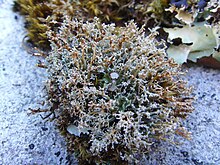
The Sphaerophoraceae are a family of lichenized fungi in the order Lecanorales. Species of this family have a widespread distribution, especially in southern temperate regions. Sphaerophoraceae was circumscribed by mycologist Elias Magnus Fries in 1831.

Glyphis is a genus of lichenized fungi in the family Graphidaceae. The genus has a widespread distribution, especially in tropical regions.
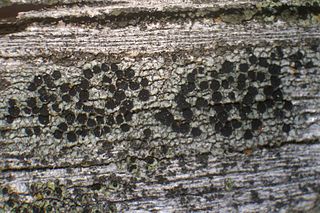
Buellia is a genus of mostly lichen-forming fungi in the family Caliciaceae. The fungi are usually part of a crustose lichen. In this case, the lichen species is given the same name as the fungus. But members may also grow as parasites on lichens (lichenicolous). The algae in the lichen is always a member of the genus Trebouxia.
Hafellia is a genus of lichenized fungi in the family Caliciaceae. The genus has a widespread distribution, especially in tropical regions, and contains five species. The genus is named in honour of Austrian lichenologist Josef Hafellner.
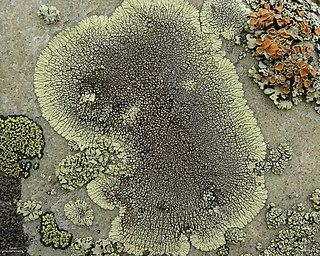
Dimelaena is a genus of rimose to areolate placoidioid crustose lichens. It is in the family Caliciaceae. Members of the genus are commonly called mountain lichens, or moonglow lichens. The genus has a widespread distribution and contains eight species.

Cyphelium is a genus of crustose areolate lichens with cup-like apothecia filled with sooty black spores. The genus is in the family Caliciaceae. The genus has a widespread distribution, especially in north and south temperate regions, and contains about 12 species. Members of the genus are commonly called soot lichens.

Physcia is a genus of lichenized fungi in the family Physciaceae. The genus name means "inflated" or "sausage-like", referring to the form of the type species. According to a 2008 estimate, the widespread genus contains 73 species.

Rinodina is a genus of lichen-forming fungi in the family Physciaceae. The genus has a widespread distribution and contains about 265 species. It is hypothesized that a few saxicolous species common to dry regions of western North America, southern Europe, North Africa and central Asia may date back 240 million years to the Middle Triassic.

Flavocetraria is a genus of lichenized ascomycete fungi in the family Parmeliaceae. The genus contains two species found in arctic-alpine and boreal regions, Flavocetraria cucullata and F. nivalis.
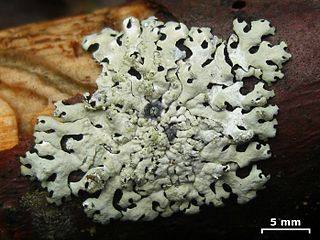
Hypotrachyna is a genus of lichenized fungi within the family Parmeliaceae. According to the Dictionary of the Fungi, the widespread genus contains about 198 species. Hypotrachyna was circumscribed by American lichenologist Mason Ellsworth Hale Jr in 1974.
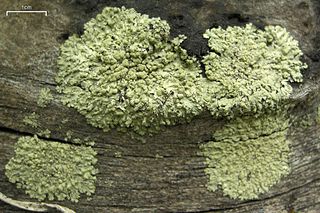
Parmeliopsis is a genus of lichens belonging to the family Parmeliaceae. The genus contains eight species that are widely distributed in north temperate areas. Members of this genus are commonly called bran lichens.
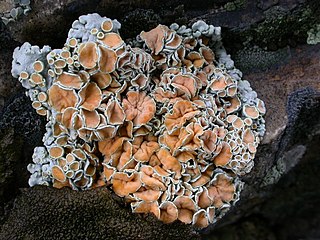
Rhizoplaca is a genus of lichenized fungi in the family Lecanoraceae. Members of the genus are commonly called rimmed navel lichens because of their umbilicate growth form and lecanorine apothecia, also rock-posy lichen and rockbright. The genus has a widespread distribution and contains 11 species.
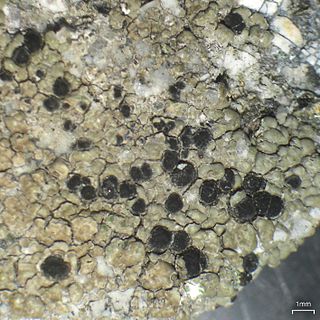
Lecidea is a genus of crustose lichens with a carbon black ring or outer margin (exciple) around the fruiting body disc (apothecium), usually found growing on (saxicolous) or in (endolithic) rock. Lichens that have such a black exciple are called lecideine, meaning "like Lecidea, even if they are not in this genus. Members of the genus are commonly called disk lichens or tile lichens.
Davidgallowaya is a genus of lichenized fungi in the family Parmeliaceae. The genus is monotypic, containing the single corticolous species Davidgallowaya cornutispora, found in Papua New Guinea. Davidgallowaya was circumscribed by Dutch lichenologist André Aptroot in 2007. The genus name honours David Galloway (1942–2014).
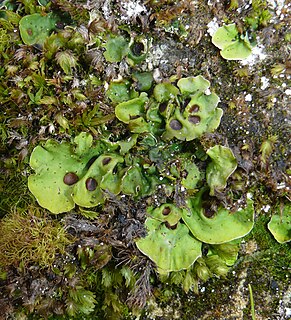
Solorina is a genus of 10 species of lichenized fungi in the family Peltigeraceae. The genus was first described by the Swedish botanist Erik Acharius in 1808. Members of the genus are commonly called socket lichens.
Leifidium is a genus of lichenized fungi in the family Sphaerophoraceae. The genus is monotypic, containing the single species Leifidium tenerum, found in Australia and South America. The genus is named in honour of Swedish lichenologist Leif Tibell.
Neophyllis a genus of lichenized fungi in the order Lecanorales. The genus contains two species found in Australasia. Originally classified in the family Cladoniaceae, the genus was transferred to the Sphaerophoraceae in 1999.

Pertusaria is a large genus of warty crustose lichens in the Pertusariaceae family. The fruiting bodies are usually modified apothecia that immersed in warts on the main body (thallus) with small holes for the spores to emerge, similar to ostioles, or are fully above and lecanorine (spore bearing discs surrounded by a ring of tissue similar to the tissue of the thallus. Members of the genus are commonly called wart lichens.

Phlyctis is a genus of lichenized fungi in the order Gyalectales, and the type genus of the family Phlyctidaceae. Members of the genus are commonly called blemished lichens.
